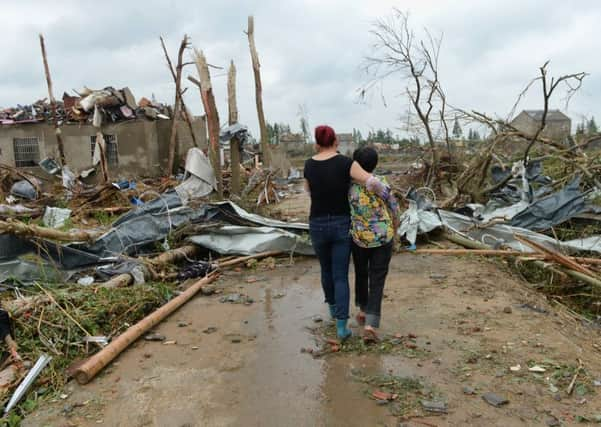98 killed and 800 injured as storm wreaks havoc in China


Accompanied by torrential rain, the tornado struck the outskirts of the city of Yancheng with counties on the city’s outskirts battered by winds of up to 80mph.
The tornado is one of the most extreme weather events witnessed by China in recent decades, leaving a swathe of destruction with destroyed buildings, smashed trees and flipped vehicles on their roofs.
Advertisement
Hide AdAdvertisement
Hide AdA sprawling solar panel factory was shredded, forcing fire crews to secure toxic materials before they leaked into nearby waterways.
According to state media, most of the 800 injured had broken bones and deep head wounds. Some were seriously ill and that the final death toll was likely to rise. Medical crews had been rushed to the area, 500 miles south of Beijing.
Rescuers carried injured villagers into ambulances and delivered food and water, while army units worked to clear roads blocked by trees, downed power lines and other debris. While the weather cleared yesterday, forecasters were warning of the possibility of more heavy rain, hailstorms and even more tornadoes.
“The people inside tried to run outside, but the wind was too strong so they couldn’t,” Xintu villager Wang Shuqing said. “My family members were all inside, they all died. The police then came and took the bodies out. I can’t bear it.”
The disaster was declared a national-level emergency, and on a trip to Uzbekistan on Chinese President Xi Jinping ordered the central government to provide all necessary assistance. Tents and other emergency supplies were being sent from Beijing, while schools and other facilities were used to shelter survivors.
Mobile phone and security camera footage showed the tornado’s debris-blackened funnel touching down and golf-ball sized hailstones falling thick as rain.
Terrified residents spoke of a “black wind” that tore the glass from all windows.
Reports said the tornado hit Funing and Sheyang counties on the city’s outskirts the hardest, with winds of up to 80 mph Tornadoes of that magnitude are considered capable of inflicting moderate damage, but the accompanying hailstorm appeared to have contributed significantly to the destruction that reduced farm buildings to piles of bricks and tiles.
Advertisement
Hide AdAdvertisement
Hide AdCars and lorries lay upside down, street light poles snapped in half, and steel electricity pylons lay crumpled. Power and telephone communications were knocked out over a wide area.
Tornadoes occasionally strike southern China during the summer, but rarely with such scale of death and damage.
Last year, a freak wind described as a tornado was blamed partly for causing a cruise ship to capsize in the mighty Yangtze River on June 1, killing 442 people.
Volatile atmospheric conditions over the Yangtze River delta are common in June when warm and cool air currents meet, but further studies are needed to determine why Thursday’s tornado was so fierce, said Ding Yihui, a researcher at the National Climate Centre of China’s Metrological Administration.
Global climate change is also seen as a factor in increasing the frequency and severity of extreme weather events, he said.